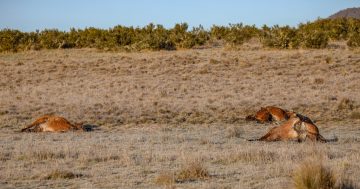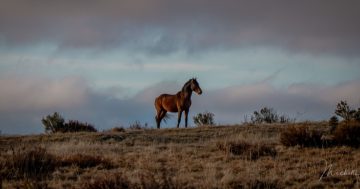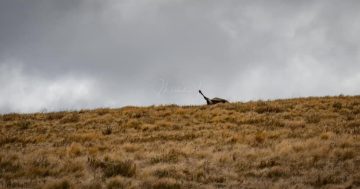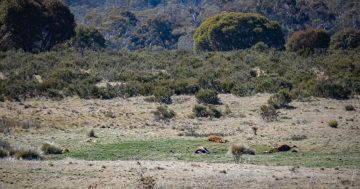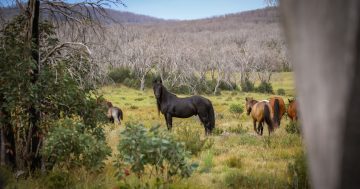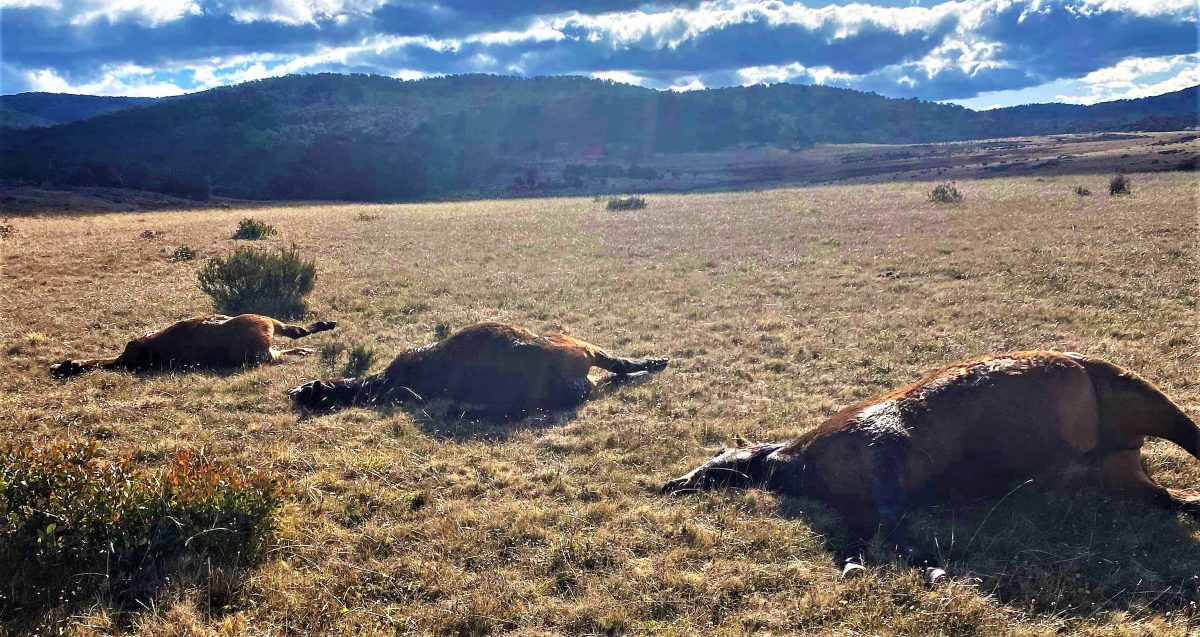
Wild horses left to rot on the Snowy Plains in Kosciuszko National Park. Image: Supplied.
The man who’d had enough of the NSW National Parks and Wildlife Service’s silence on brumby carcasses in Kosciuszko National Park said dumping a horse’s head at the department’s Jindabyne office was intended to make a point.
Rocky Harvey took the head of one of the 67 brumbies recently shot and left to rot on Snowy Plains and dropped it off at the NPWS office, incurring himself a $500 offensive behaviour fine.
But Mr Harvey considered the authority’s failure to properly dispose of the carcasses offensive.
He’s received more positive than negative feedback for his actions, which he felt summed up the general public’s opinion of the NPWS’s actions.
“I don’t have an issue with brumby numbers, but it’s the way they go about things,” he said. “If I had 60-odd carcasses rotting on my land, I’d be crucified.”
“They (NPWS) have no social licence to do what they have done. It’s the arrogance of the NPWS which is now leading to this backlash. It’s just crazy”.
Acting Environment and Heritage Coordinator-General Atticus Fleming, who oversees the NPWS, defended the department’s actions, saying it was natural for carcasses to be in the park. Refuting fears around scavenger activity, he said NPWS had increased wild dog baiting by six times the usual volume.
Lisa Rowbotham, whose land adjoins Snowy Plains, said she received no notification of the ground shooting cull.
“I’ve done some research and found the NPWS has an 18-point neighbour relations policy,” Ms Rowbotham said. “They have not followed even one of those points.
“We’ve always been pretty tolerant of NPWS as a neighbour, but now it’s game on,” she said.
Combined with unauthorised shooters in the area, she’s concerned for her livestock and has moved her horses away from the area, for fear of them being shot too.
Ms Rowbotham repudiated Mr Fleming’s claims carcasses would not attract pigs or dogs, saying “the dogs have already moved in”. Local trappers confirmed wild dogs are very active.
“The brumby debate is a whole other thing,” she said. “We like having brumbies there because they’re our buffer zone. We’ve already nearly been burnt out three times and if horses aren’t there, that country will scrub up right to the fence and there goes our buffer.”
She concurs with former MP Peter Cochran, who has called for a Royal Commission into the NPWS activities.
“The whole thing is, no one is blaming local staff. These decisions are made somewhere else, but we don’t have access to policymakers higher up. It’s beyond frustrating,” she said.
While the government plans to cull 15,000 wild horses within five years, biosecurity concerns are playing second fiddle to impacts on groundwater and waterways.
Footage of decomposing remains downriver from Lake Jindabyne was captured in September 2022 by Ian and Michelle Brown of Snowy Brumby Photography Adventures.
“You can see that whole area is a water catchment area, you can see all the little streams and creeks in pristine condition feed the Eucumbene River, but NPWS have left 12 horses there to rot. Last week they stated it’s against their management practices and policy to leave dead horses near water, yet this whole area is catchment,” Mr Brown said.
He contacted the NSW Environmental Protection Authority (EPA) twice to report potentially polluted waters in Kosciuszko National Park. “They said they were interested so I sent them what I had but I never heard back from them.”
NSW EPA said Mr Brown’s reports were not a matter for them and had referred them to the NPWS in October 2022.
The NPWS told Region there are no horse carcasses in waterways.
“The NSW NPWS is under a legal obligation to reduce the population of wild horses under the Wild Horse Heritage Management Plan,” a spokesperson said.
The NSW Department of Primary Industry (DPI) states under the Animal Biosecurity and Welfare Strategic Plan (2021) that “improper carcass disposal can have significant impacts on environmental, human and animal health”, noting the potential for contamination.
It further emphasises the importance of careful planning and management of disposal by owners to ensure the safety of the community, other stock and the environment, and minimising the risk of disease.
NSW DPI told Region the matter of carcass disposal sat with the Office of Environment and Heritage. The 2021 Kosciuszko National Park Wild Horse Heritage Management Plan says the disposal of carcasses presents logistical challenges, including numbers, access, available resources and environmental constraints.
It notes a range of management options, to be considered on a case-by-case basis with site-specific requirements.
Despite repeated requests for specifics, none were provided by NPWS or Environment Minister Penny Sharpe.
The minister wouldn’t confirm if the department had consulted with the DPI on methods of carcass disposal to prevent contamination of water (ground and waterways) and to ensure the safety of the community, other stock, the environment and disease spread.
No assurances have been offered by the minister on the safety of users, visitors and KNP neighbours as culling operations continue.






